Sometimes when you are trying a new recipe, things don't go right. I have less of a problem with this because I usually don't follow recipes that closely as long as I know what should be the end result. Compared to my rather free wheeling approach, my wife tends to follow recipes more precisely (which anyone in their right mind should do). She read this rather healthy sounding recipe for baked eggplant, zucchini and tomato. It was a bit complicated. The eggplant, was not the Japanese variety and needed to be peeled, sliced, salted to remove the bitterness and prebaked with olive oil. Then, the eggplant slices, zucchini, and slices of tomatoes (she used canned whole plum tomatoes) were layered in a baking dish topped with seasoned bread crumbs (panko, thyme, oregano) and repeat the layers. We thought putting the bread crumbs in the middle of the layers did not make sense but that was what the recipe called for. The resulting dish was certainly edible (good flavor) but everything was mushy and the wet bread crumbs in the middle layer were not good. My wife was extremely disappointed and ready to throw it out. But, I said, "Wait, since everything is mushy why not mush it all up and make it into a dip like babaghanoush" which is supposed to be mushy. Only difference between this dish and "Baba Ghaoushu" are the zuchini, tomato and bread crumbs (come to think of it, that is quite a difference. The only common link is the eggplant).

But that did not deter me. I just put this mixture of the baked zucchini, eggplant, tomato, and bread crumbs in the mixing cup of an immersion blender, added some lemon juice, tahini (I used Japanese white sesame paste), crushed garlic and blended it. After tasting it, I added a small amount of good extra virgin olive oil, salt, and black pepper. Finally I added finely chopped parsley for color and fresh taste. It turned out to be pretty good (and was great as a spread on sandwiches). It is sort of "Baba ghanoushu" but because of the tomato, olive oil, and bread which acted as thickener, it has the flavor profile of Gazpacho. It is a very wonderful new-age fusion dip which I henceforth named "Baba Gazpa-noushu". I also made guacamole and hummus to complete a trio of ethnically confused dips.
Thursday, May 27, 2010
Baba Ghanoushu, Gazpacho flavored or "Baba Gazpa-nouchu" ガスパッチョ味のババガヌーシュ
Tuesday, May 25, 2010
Chicken wing "Teba" Gyoza 手羽餃子
This dish must have been invented after I left Japan. It is a wonderful dish except for being rather fatty or, if I borrow the expression from the Japanese food critic who appears on Iron Chef America, "too oily". We first had this in a small Yakitori place (now defunct) run by a middle-aged husband and wife team, on a narrow alley way near the downtown "Yon-chome" 4丁目 intersection in Sapporo 札幌 some time ago while we were visiting Japan. Essentially this dish is a Japanese sausage with the skin of chicken wings as the casing. After removing the bones from the chicken wing, stuff the wing part with the pork gyoza mixture (leaving the wing tip as a handle so that you can hold it while you eat). Somehow, this dish reminds me of a "Turducken". The original recipe is to deep fry this to make it really deadly. This time, I followed the original way of cooking but I promise I will work on making this less deadly by either baking it in a high temp oven or grilling it. If I am successful you will see it in my future postings.
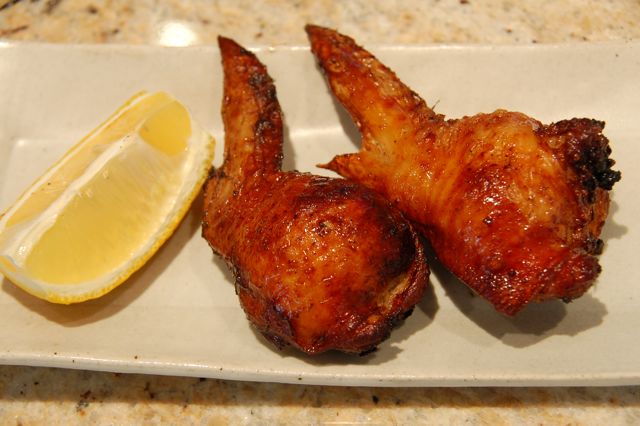
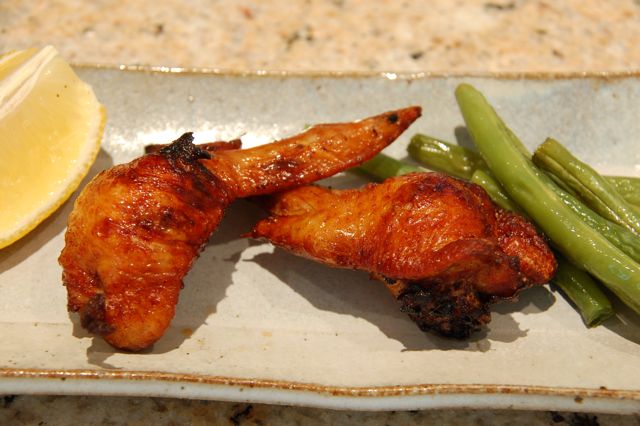
My wife made baked green beans (just coat them with olive oil, salt and black pepper and spread in one layer in the cookie sheet and bake them for 30 minutes at 350F), which is the best way to cook green beans. They become very sweet and better than boiling or steaming. So, I added the green beans as a side after I took the first picture.
Chicken wings: I remove the drummetts (use for another dish) but leave the wing tips. Using a small knife, separate the meat around the two bones (equivalent to the "ulna" and "radius", if you would like to know) and pull the skin and meat down to expose the joint. I grab the ends of the bones and rotate and wiggle until both come off the joint. Please take care not to cut or break the skin. Now you have created the pocket.
Gyoza stuffing: This is the usual pork stuffing for gyoza. I made much more than I intend to use for this dish so that I could make regular gyoza later. We happened to grow garlic chives in our herb garden, so I added that as well. As usual, I used the trimming from a pork tenderloin and, by using a chef's knife, chopped up finely into ground pork (probably 1 cup). I added chopped garlic chives (probably 3 tbs), blanched and finely chopped cabbage (4 tbs), finely chopped scallion (2 tbs), crushed garlic (1 fat clove), grated ginger (1 tsp), salt (1/2 tsp), black pepper (1/2 tsp), mirin (2 tbs), soy sauce (1 tbs), sesame oil (2-3 tbs) and knead by hand until it become nicely elastic and bound together.
Assembly and frying: Stuff the wing pocket with the gyoza mixture and close it by inserting a tooth pick through the skin at the opening. I shallow fry as usual rather than deep dry. At about 160F (I actually did not measure but used the stick-bamboo-chopsticks-in-oil method as usual) for 5-7 minutes turning several times. I took them out of the oil. I then cranked up the flame and, briefly, re-fried to make the skin crispy. I cut into the fattest one to make sure the pork is thoroughly cooked (which it was).
This dish is very good, although the skin was "oily" and could have been crispier. Since it is a type of sausage with a Japanese twist, it will go well with a cold beer but we had this with a red wine, Brookdale Cab Sauv from Napa, to counteract the effect of the fat.
Sunday, May 23, 2010
Braised Fiddlehead fern with Konnyaku and aburaage ぜんまい、コンニャク、油揚の炒め物
Japanese like to eat seasonal "Sansai" 山菜 or mountain vegetables. These are wild vegetables collected from the mountains. One of them is furled fern leaves called "Zenmai" ぜんまい (which means a spring such as those used in wind-up toys--for it's obvious resemblance) or "Warabi" 蕨 (Both are ferns but with some subtle difference). As a kid, I was not crazy about this vegetable but as you get older (as I am), you remember and get nostalgic about the food you tasted as a kid. In North America, Fiddle head fern (which is very similar to the Japanese Zenmai) is harvested (very seasonal) from the wild and eaten especially in Eastern Canada and New England. When I saw fresh Fiddle head fern in our neighborhood gourmet supermarket, I decided to make a small dish in the Izakaya food category. In its raw form, fiddle head ferns contain some toxins and need to be prepared properly before being consumed.
I wash the Fiddle head ferns well in several changes of cold running water and remove discolored ends of the stems. I boil the fern in a large amount of salted water for 5 minutes (The water browns in the first boil). I drain them in a colander, then wash in cold water. Repeat this process twice more (total of 15 minutes cooking or boiling time and three changes of water). This process is called "nikobosu" 煮こぼす (boil and drain) in the Japanese cooking parlance. After the last boiling and draining, place them in a sealed container with an ample amount of cold water. I leave it in the refrigerator overnight. Once this preparation is done, it is fairly easy to use the Fiddle head fern in a dish. I decided to make a rather rustic Izakaya or home style dish.
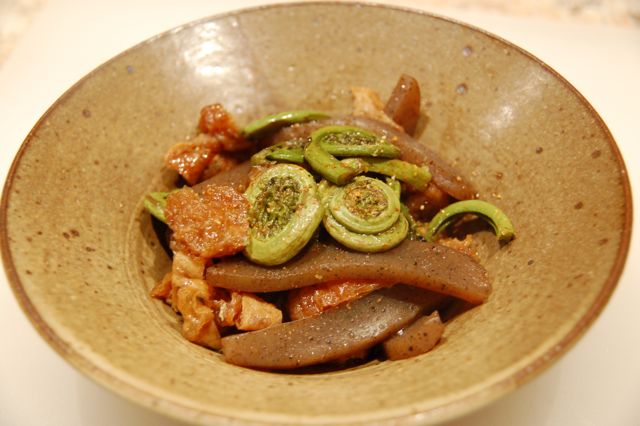
I am not sure how much Fiddle head ferns I had but they are just enough for two small servings (probably 15-20 heads). Devils tongue or konnyaku (alternative spelling=Konjac) 蒟蒻 (I used about half) is blanched for a few minutes and sliced into thin strips. Two aburaage 油揚げ (small koage 小揚げ or ianari 稲荷 kind) were also blanched and the water squeezed out, then cut into thin strips. I put peanut oil (1tbs) with a dash of dark sesame oil in a frying pan. When the oil was hot, I added the drained Fiddle head fern, sauteed for 1-2 minutes and added the strips of konnyuaku and aburaage and sauteed another minute or two. I added mirin (1tbs) and soy sauce (1 tbs) and Japanese 7 flavor red pepper powder 七味唐辛子 to taste and braised until the liquid was almost all gone.
I wash the Fiddle head ferns well in several changes of cold running water and remove discolored ends of the stems. I boil the fern in a large amount of salted water for 5 minutes (The water browns in the first boil). I drain them in a colander, then wash in cold water. Repeat this process twice more (total of 15 minutes cooking or boiling time and three changes of water). This process is called "nikobosu" 煮こぼす (boil and drain) in the Japanese cooking parlance. After the last boiling and draining, place them in a sealed container with an ample amount of cold water. I leave it in the refrigerator overnight. Once this preparation is done, it is fairly easy to use the Fiddle head fern in a dish. I decided to make a rather rustic Izakaya or home style dish.
The Fiddle head fern has an interesting texture and flavor. With a combination of konnyaku and aburaage and some spiciness, this is a good rustic dish but given the amount of preparation required, I am not sure if I will make this often (probably once a year).
Saturday, May 22, 2010
Sushi Taro, Dupont Circle, Washington DC 寿司太郎
The Dupont Circle area has undergone significant change over the years and is now a very vibrant neighborhood with numerous good restaurants. It also was my wife's old stomping grounds. This Japanese restaurant, Sushi Taro, used to be your usual run-of-the mill sushi bar/ tempura place. It occupies the second floor of an unassuming brown square building at the corner of 17th and P, with a CVS Drug store on the ground level. Last year it went though a major renovation, when the old owner's son, Nobu Yamazaki (pictured below), took over. He transformed the place into a high-end Kaiseki and Omakase Japanese restaurant. We went to the old Sushi Taro a few times and were not particularly impressed. It was a very ordinary sushi bar. After this drastic transformation, however, we have been back three times; twice for sushi omakase and once for regular Kaiseki omakase.

(From Washington post)
This time we started off with home-made umeshu 梅酒 aperitif with green plum simmered in syrup or "kanroni" 青梅の甘露煮, a very nice refreshing start, which was followed by their signature appetizer Gomadofu 胡麻豆腐 topped with Maine sea urchin, real wasabi (every time wasabi was served, our chef grated a wasabi daikon root with a traditional sharkskin grater--the difference between this wasabi and the usual fake one from the tube was remarkable). Since it was in season, the next was Junsai ジュンサイ in sweet vinegar and yuzu 柚子. Junsai was very fresh with thick gelatinous layers. It matched perfectly with gentle sweet vinegar sauce highlighted with a bright yuzu flavor. (Masa showed us the fresh yuzu they had just received--the very small green kind). We then moved to a simmered dish; Hiryouzu 飛龍頭 and shrimp shinjou 海老しんじょう in yuba 湯葉 sauce. This was a nice comforting dish and well-prepared, if not spectacular. Next came a huge and fresh Pacific oyster (cut into three pieces) from Washington State, Japanese call it Iwagaki oyster 岩牡蛎, on the half shell with a lemon wedge and okinawan salt. This was so good (you may have noticed we are partial to raw oysters). It went so well with the sake we were drinking; a nice fresh ocean taste and, without any special sauce or seasoning, it lingered pleasantly in the mouth for a while. Again seasonality is important here. "Ayu" 鮎 is in season. Japanese, especially Kyotoites, are very fond of this small fresh water river fish and we had this fish quite a few times in Kyoto. The Ayu which had been marinated very delicately in soy sauce and sake 祐庵地 was served butterflied and grilled 鮎の開き祐庵焼き. I like this rendition much better than the customary "shioyaki"塩焼き or salt grilled, which is usually served on a bed of salt and pine needles. Somewhere between these dishes, we had assorted "Hassun" appetizers 八寸 with 8 small tasty morsels; kinome-miso dengaku 木の芽味噌田楽, "aburana" with yuzu-miso アブラナの柚子味噌和え, lightly marinated firefly squid 蛍イカの沖漬け, "tamago-dofu" 卵豆腐, a small savory egg custard square with edamame paste, salt-cured shirako 白子 with vinegard daikon strips, garlic sprouts 芽ニンニク with miso-marinated Manila clams. All were fantastic. The only slight disappointment being the dengaku due to the quality of the tofu which could have been better. The salt cured "Shirako" or cod sperm sac (which does not sound appetizing) was delicate and tasty.
 I just want to mention sakes we tasted at Sushi Taro on three occasions. The sake list is not extremely long but quite decent covering from the high-end to moderate. Among the ones we tasted; Muromachi Jidai 室町時代 (Junmai Supreme-Daigijo or Kiwami-daiginjo), Hakkaisan 八海山 (Ginjou), Kubota Hekiju 久保田 蒼寿 (Junmai Daiginjou), Dassai23 獺祭 (Junmai Daiginjo) and Hakuryu 白龍 (Daiginjo). By far, "Muromachi Jidai" is our favorite. Complex yet clean tasting and it is just cut above. Next will be Dassai23. Not as complex but very pleasant and clean. Hakkaisan is a bit too yeasty to our taste. Kubota has some muddy note and Hakuryu is rather simplistic.
I just want to mention sakes we tasted at Sushi Taro on three occasions. The sake list is not extremely long but quite decent covering from the high-end to moderate. Among the ones we tasted; Muromachi Jidai 室町時代 (Junmai Supreme-Daigijo or Kiwami-daiginjo), Hakkaisan 八海山 (Ginjou), Kubota Hekiju 久保田 蒼寿 (Junmai Daiginjou), Dassai23 獺祭 (Junmai Daiginjo) and Hakuryu 白龍 (Daiginjo). By far, "Muromachi Jidai" is our favorite. Complex yet clean tasting and it is just cut above. Next will be Dassai23. Not as complex but very pleasant and clean. Hakkaisan is a bit too yeasty to our taste. Kubota has some muddy note and Hakuryu is rather simplistic.
Sushi omakase takes place in a room, separated from the main dining area, with a light-colored wood counter which only seats 6, Nobu himself and Chef de cuisin Masa Kitayama are behind the counter, where the cooking area is rather large with a charcoal burning Konro grill (exactly the same as the one we have) in the back counter in front of a picture window overlooking a stand of bamboo. The setting is very similar to a high-end sushi bar in Japan as described by Jon. The atmosphere is very intimate and quiet. With capacity for only six customers, the customers have the complete attention of the chefs. The night we were there only 4 customers, including ourselves, were in attendance. This time we feasted for over 3 hours with 12 courses--and this is not counting each individual piece of sashimi and sushi. This feast was much more than sushi and sashimi omakase as you will see.
This time we started off with home-made umeshu 梅酒 aperitif with green plum simmered in syrup or "kanroni" 青梅の甘露煮, a very nice refreshing start, which was followed by their signature appetizer Gomadofu 胡麻豆腐 topped with Maine sea urchin, real wasabi (every time wasabi was served, our chef grated a wasabi daikon root with a traditional sharkskin grater--the difference between this wasabi and the usual fake one from the tube was remarkable). Since it was in season, the next was Junsai ジュンサイ in sweet vinegar and yuzu 柚子. Junsai was very fresh with thick gelatinous layers. It matched perfectly with gentle sweet vinegar sauce highlighted with a bright yuzu flavor. (Masa showed us the fresh yuzu they had just received--the very small green kind). We then moved to a simmered dish; Hiryouzu 飛龍頭 and shrimp shinjou 海老しんじょう in yuba 湯葉 sauce. This was a nice comforting dish and well-prepared, if not spectacular. Next came a huge and fresh Pacific oyster (cut into three pieces) from Washington State, Japanese call it Iwagaki oyster 岩牡蛎, on the half shell with a lemon wedge and okinawan salt. This was so good (you may have noticed we are partial to raw oysters). It went so well with the sake we were drinking; a nice fresh ocean taste and, without any special sauce or seasoning, it lingered pleasantly in the mouth for a while. Again seasonality is important here. "Ayu" 鮎 is in season. Japanese, especially Kyotoites, are very fond of this small fresh water river fish and we had this fish quite a few times in Kyoto. The Ayu which had been marinated very delicately in soy sauce and sake 祐庵地 was served butterflied and grilled 鮎の開き祐庵焼き. I like this rendition much better than the customary "shioyaki"塩焼き or salt grilled, which is usually served on a bed of salt and pine needles. Somewhere between these dishes, we had assorted "Hassun" appetizers 八寸 with 8 small tasty morsels; kinome-miso dengaku 木の芽味噌田楽, "aburana" with yuzu-miso アブラナの柚子味噌和え, lightly marinated firefly squid 蛍イカの沖漬け, "tamago-dofu" 卵豆腐, a small savory egg custard square with edamame paste, salt-cured shirako 白子 with vinegard daikon strips, garlic sprouts 芽ニンニク with miso-marinated Manila clams. All were fantastic. The only slight disappointment being the dengaku due to the quality of the tofu which could have been better. The salt cured "Shirako" or cod sperm sac (which does not sound appetizing) was delicate and tasty.
At this point, we were presented with two choices; one was "Lobster" shabushabu and the other was a Japanese style snapping turtle soup スッポンのお吸い物. Without hesitation, we took the snapping turtle. This was quite a soup; mine had one of the legs and my wife's had nice meaty parts. The broth was very savory. Yet the shimmering liquid in the bowl did not completely cover up the underlying primordial reptilian taste suggestive of mysteriously lurking depths of the pond. This does not taste like a chicken for sure. Since I got the leg, I had to spit out the "nails" as I chowed down.
Since I made the reservation directly with Chef Masa and mentioned that the last time we were there we liked his home-made "Karasumi" からすみ, he gave us a small slice of that dreaded "Funazushi" フナ寿司 which was marinated with sake lee. Marinating in sake lee or "Sake kasu" 酒粕 made it very palatable (actually good). It had a similar texture and taste to "Karasumi". What a personal service!
Then, we were presented with several square lacquer boxes of today's sashimi items. One box was all "hikarimonoayu" offered as sashimi. We started with a series of sashimi, very small but carefully prepared pieces; tuna around this time of year was less fatty and firm but very tasty. Again, freshly grated wasabi was just so nice. We can not remember every pieces we had but other stand-outs are "sayori" or needle fish, "Ayu" served two ways (one as is-just salt cured, and the other mixed with salted and preserved ayu innards called "Uruka" うるか. Ayu innards are cherished for their slightly bitter taste. Uruka definitely added a salty and slight bitter taste but it was a nice combination of tastes. I can not forget the wild white salmon from Alaska. Very tasty. Oh, one more item worth mentioning is, again in season, bonito "katsuo" 鰹 which was lightly grilled on a charcoal fire (Tataki) and served in a separate bowl with grated garlic and ginger; nice meaty slices and very flavourful. I have eaten a great deal of sashimi in my day but somehow this was especially good. Between the sashimi and sushi course we were offered a small delicately done "Sayori tempura" with perilla leaves さよりの天ぷら. At this point we were so full it was an effort to finish the sushi. Masa responded by making the rice ball very small for us and we had 4-5 pieces of yummy sushi.
Finally, we were presented with the desert menu. We picked a Japanese "purin" custard, "kurosatou" or dark sugar (from Okinawa) ice cream. Both were very good but we particularly liked the very delicate Japanese custard.
In summary, we really like this place. This is one of the best restaurants we have eaten at both here and in Japan. They serve very traditional carefully created food with a keen sense of seasonality ("Shun" 旬) and the sake selection is quite decent. The only problem for us (if you can even call it a problem for most people) is that we get so full by the end of the feast in both Sushi omakase and regular Kaiseki. It is a bit expensive but a similar class restaurant in Japan will certainly cost much more.
Thursday, May 20, 2010
Kinpira Celery セロリの金平
I saw this dish in Dave P's review of "En" in Kichijouji 吉祥寺. "Kinpira" 金平 is a very simple Japanese way of braising thinly sliced or julienned vegetables, seasoned with mirin and soy sauce. Burdock or "gobo" 牛蒡 is the most common. I have made "kinpira" with diakon, carrot, lotus root or "renkon" 蓮根 beside gobo but celery is a nice idea.
Tuesday, May 18, 2010
Stewed rolled daikon and deep fried tofu 大根と油揚の砧の煮物
This is another high-labor simple ingredient dish (it is a value added item and "you can charge more for this dish than for a simple nimono or simmered dish" is what I remember it said in the cookbook from which I got this recipe). Although I cannot charge more for this dish, I decided to make it because my wife found several Ziploc bags of half used packages of deep fried tofu pouches or "obraage" 油揚げ in our freezer, apparently representing different vintages. Since these things do not improve with age, I tried to use up the older vintage aburaage. I made this dish a few times before and I remember that it tastes pretty good. I made this at the same time I made "Kanpyo with checkered daikon and carrot" カンピョウの市松 and the original recipe came from the same cookbook ("Appetizers and a la carte small dishes for Izakaya" by Tadashi Shinojima.)
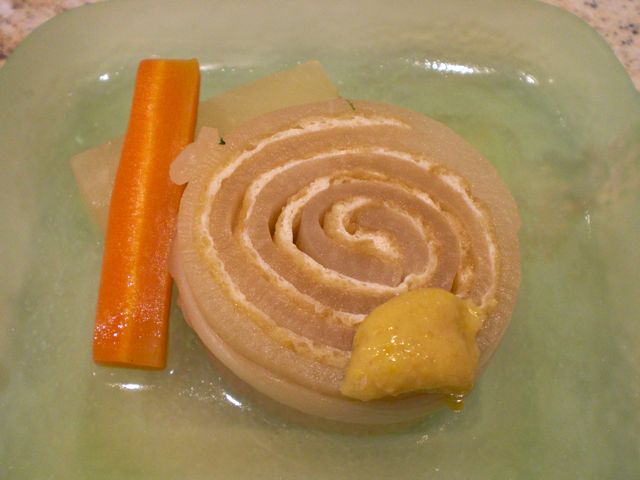
(This is the way I served it the day I made this dish)
First, I soaked 6 "Inari" 稲荷 or "koage" 小揚げ type (i.e. small) aburaage in boiling water to thaw and remove excess oil. While taking care not to burn my hands, I squeezed out any water it may have absorbed by pressing it between my palms. I then cut three edges of the aburaage and opened it up into a flat rectangular sheet (about 3 by 5 inches). I repeated this process with the rest of the abraage and set aside.
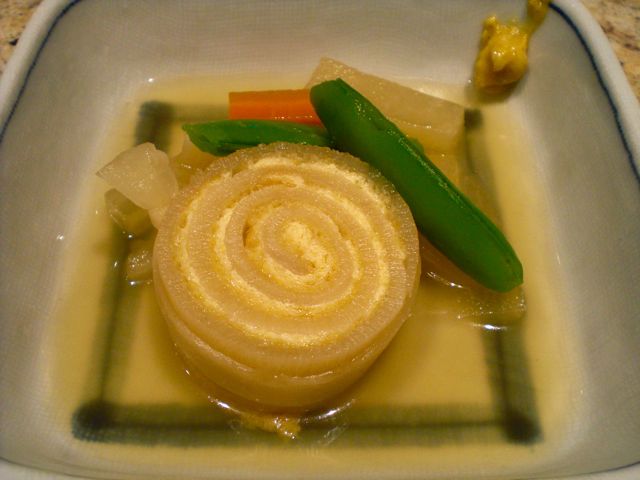
(The next day, with sugar snap)
First, I soaked 6 "Inari" 稲荷 or "koage" 小揚げ type (i.e. small) aburaage in boiling water to thaw and remove excess oil. While taking care not to burn my hands, I squeezed out any water it may have absorbed by pressing it between my palms. I then cut three edges of the aburaage and opened it up into a flat rectangular sheet (about 3 by 5 inches). I repeated this process with the rest of the abraage and set aside.
I happened to have a rather large good daikon. I cut about a 5 inch-long (corresponding to the width of the aburaage sheets) segment of daikon. Using "Katsura-muki" 桂剝き, after peeling off the skin, I made a long thin sheet of daikon (it should be thicker -about 3mm- than when you make a daikon garnish for sashimi). I managed to make 3 sheets, each about 13-14 inch long. I blanched the diakon sheets for 5 minutes so that it would be more pliable. When it cooled enough to handle, I layered the aburage on top of the dakon sheet. You need two abuaage sheets to cover 80% of the diakon sheet leaving about 3-4 inches at the end (which makes the outer most layer). I rolled up both together and tied the upper and lower portions of the resulting cylinder with Kanpyo 干瓢 (I cut the width of the Kanpyo ribbon in half since this one happened to be rather wide). I made three rolls (each will be cut in half when served yielding 6 pieces). I placed the rolls on their ends in a small deep pot containing dashi broth (abut 2-3 cups--enough to just cover the daikon cylinder), mirin (3 tbs), "usukuchi" 薄口 soy sauce (3 tbs). The original recipe calls for dashi, mirin and sugar without any soy sauce but this does not make sense to me, so I omitted the sugar and added soy sauce. With "otoshibuta" 落とし蓋, gently simmer for 30-40 minutes. Before serving, I cut the cylinder in half between two Kanpyo ties to make two disks. Serve with the cut end up (looks much nicer) with a dab of Japanese hot mustard and a bit of the broth. The combination of texture (still slightly crunchy daikon and gentle softness of obraage), subtle and gentle sweetness from daikon and the broth, all produced a sublime experience punctuated by loud wake-up calls from the Japanese hot mustard. Sake is definitely called for.
Sunday, May 16, 2010
Cocktail カクテル
We very rarely drink hard liquor or cocktails nowadays. Red wine and sake are more agreeable most of the time. But if the occasion calls for it like today, we enjoy a cocktail. I usually go for a Martini and my wife for a Manhattan. I think that, the quality of the gin, bourbon, and vermouth or whatever you are using is, of course, important. There are other very important details that make the cocktails especially good. The first is the glass. It has to be a very thin rimmed crystal so that when it touches your lip, it gives you a nice sensation. A thick cheap cocktail glass actually made of glass does not do it. Second, the glass and the ingredients have to be very cold. I chill the glasses by pouring crushed ice mixed with cold water into them first. Using a cocktail shaker with enough crushed ice (-10F ice from a freezer is better than ice from a stand alone ice maker some establishments may use, which is not as cold) is also important so that the cocktail is super cold. Tiny ice crystals should float on the surface when poured. Third, the garnish--a good stuffed green olive for the Martini and maraschino cherries for the Manhattan. In the case of my wife, make that two maraschino cherries. (Its a long story having to do with good family times, and the distribution, to the kids, of Maraschino cherries, one each, from a Grandma and Grandpa who liked Manhattans but not the Maraschino's that came in them). Of course instead of having a cocktail in a dark and smoky bar, we like to have it in our backyard on the weekend when the weather is perfect--sunny, cool and no mosquitoes, like today. We had small canapes of creme fraiche, capers and smoked salmon on small squares of Pumpernickel with the cocktails. We had to admit, though, if there is a nice Izakaya nearby like this one, we may change our mind and venue (especially if it was a weekday evening).
Subscribe to:
Comments (Atom)


